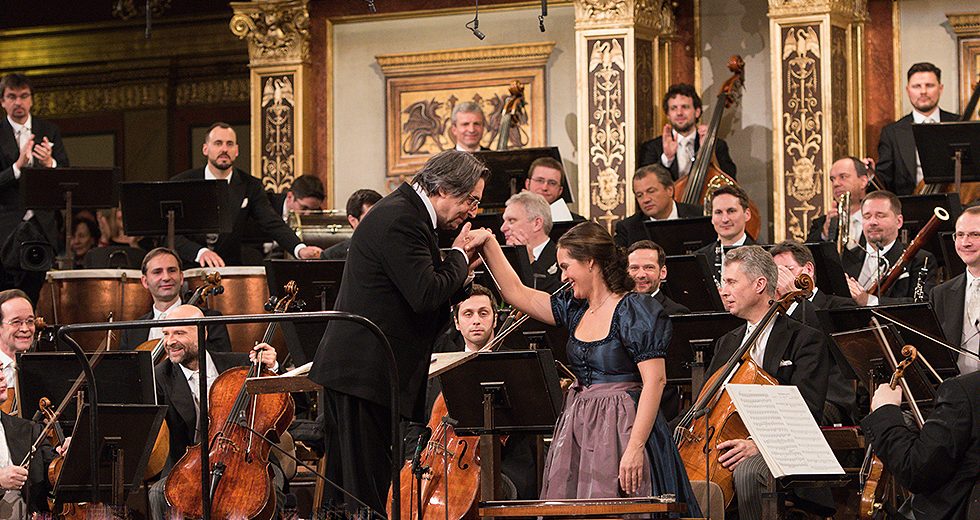
“An Homage to Beauty” read the headline in Kronen Zeitung after Riccardo Muti’s fifth New Year’s Concert with the Vienna Philharmonic at Vienna’s Musikverein. This celebrated annual event was televised and broadcast on New Year’s Day to as many as 50 million across more than 95 countries, and is now available on CD and digital versions, and soon, on DVD.
The Vienna Philharmonic’s New Year’s Concert is a long-standing tradition that dates to the late 1930s and early 1940s when the festive music of the Strauss family and their contemporaries provided welcome relief during a dark time in Austrian history. With their celebratory tone and masterful interpretations of Vienna’s signature waltzes, marches and polkas, the concerts have continually grown in popularity and usher in each New Year with joy and optimism.
Muti, Zell Music Director of the Chicago Symphony Orchestra, captured this atmosphere perfectly, conducting with “charisma, elegance, transparency, and fire, when appropriate,” according to Milan-based newspaper Corriere della Sera as he led the ensemble with which he has had a close relationship since 1971. “After nearly 50 years of uninterrupted collaboration, Muti’s understanding of the Viennese style is perfect” declared Turin’s La Stampa, and “thus, the conductor needs only a few gestures to achieve a fruitful fine-tuning.”
Several reviews referenced Muti’s “light touch” and “special Italianate elegance.” The Salzburger Nachrichten noted that “Muti stimulated rather than tamed the musicians,” much in the same way legendary maestro Arturo Toscanini made it a point for the conductor never to “disturb the musicians.” “The musicians are grateful,” wrote Wilhelm Sinkovicz of Vienna’s Die Presse.
“As they certainly perform with the required precision but also artfully present a variety of colors, often tongue-in-cheek as if they wanted to say: yes, we can play it like this, too. After all, the legendary Viennese three-quarter time schmaltz requires precision, a kind of precision that simply can only be mastered in this nation,” said Die Presse. “Muti knows that, and in the key moments, he gives the Philharmonic free rein, free rhythm. In return, he insists on exactness when he knows he is right.”
Muti also was praised for capturing the “elusive mix in which both beauty and political significance were honored,” wrote Karlheinz Roschitz of Vienna’s Kronen Zeitung. “He is the grand seigneur among the star conductors, a sound magician, who, with just a few gestures, evokes beauty, love and passion with the Vienna Philharmonic. But also, melancholy, Strauss’ famous ‘tear in the eye.’ And he relishes the sumptuous festiveness of Strauss.”
Muti added an Italian touch to this program by including works inspired by that nation and its composers, such as Franz von Suppé’s Overture to Boccaccio, Johann Strauss Sr.’s homage to Rossini with his William Tell Gallop and Johann Strauss Jr.’s inventive Quadrille, inspired by music from Verdi’s Un ballo in maschera. Another special treat was Alphons Czibulka’s Stephanie’s Gavotte, composed for the introduction of Crown Prince Rudolf’s bride in Vienna. “With this, Muti once again proved his sense for [championing] composers [who] are almost forgotten today,” wrote Roschitz.
The Blue Danube Waltz and the Radetzky March brought the concert to a festive close. The performance was met with thunderous applause and standing ovations, causing critics in attendance to agree that it was Muti’s greatest New Year’s Concert yet. Here’s hoping that he may choose to welcome in the New Year with the Vienna Philharmonic once again in the future.
TOP: Riccardo Muti kisses the hand of the zither soloist at the 2018 New Year’s Concert with the Vienna Philharmonic. | Photo: Terry Linke